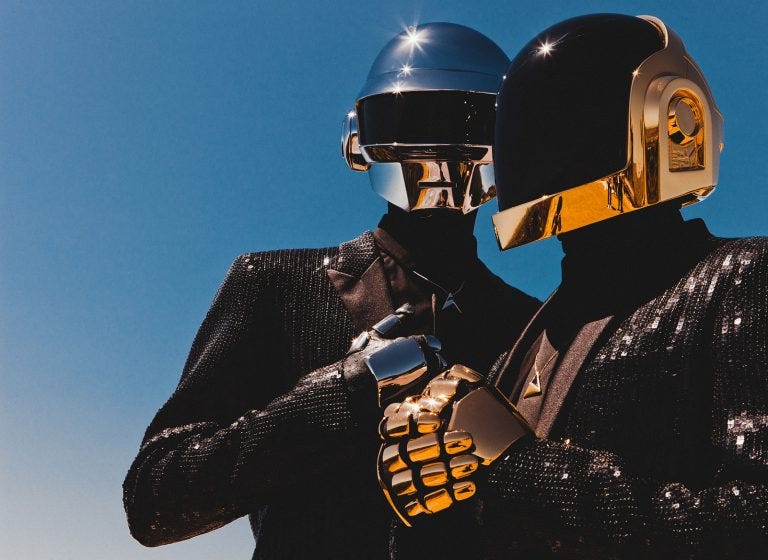Discovery - Daft Punk
An electric disco house album with hits that will get everyone up on their feet tomorrow and decades from now.
Setting the Scene:
The French electronic duo, Daft Punk, was composed of two members, Thomas Bangalter and Guy-Manuel de Homem-Christo. They had initially started and failed as an indie band named Darlin’, but then decided to pivot towards electronic music. In 1997, they had started to create a name for themselves in house music with their debut album Homework. Several of the singles off the album, such as “Around the World” and “Da Funk,” received critical success and peaked as number-one singles on the Billboard Hot Dance/Club Play charts. For their next album, Daft Punk decided to continue making house music, but pulled influences from disco. The duo utilized a lot of sampling for the album and even used it as a catalyst of their new identities. In an interview, leading up to the release of their next album, Bangalter said that there had been an accident in the studio while working on their sampler. He stated that at 9:09 A.M. on September 9, 1999, the sampler exploded and converted the duo into robots. From this point onwards the group was always seen with their signature helmets and metallic gloves. In 2001, Daft Punk released their second album, Discovery. The duo described the album as a concept album that reflected the way they listened to music in their youth, with playfulness and open-mindedness. It also drew from the group’s love for movies which is most clearly seen by the accompanying movie that the pair released for their album, Interstella 5555: The 5tory of the 5ecret 5tar 5ystem, which uses the entirety of Discovery’s tracklist in the film to tell a sci-fi story.
Personal Thoughts:
From the iconic opening notes on the opener for Discovery, “One More Time,” Daft Punk throws us into their disco house dance floor. Then they transition to an electronic love song two songs later on “Digital Love.” Soon after, they drastically decrease the tempo on “Nightvision” but still capture the dance feel through a synth driven slow dance song. Towards the end of the album, they show us a melodic and emotional side to the house music they’re making on “Veridis Quo.” All of this is to say that, without uttering many words, Daft Punk has been able to infuse Discovery with so many different styles and moods. The really remarkable thing about this, is that Daft Punk has managed to find a way to make people feel all these emotions, and also found a way to make people want to keep dancing through all of it.
On “One More Time,” Daft Punk sets the tone immediately with an instrumental groove and a chorus that is catchy. The lyrics encourage you to just have a good time:
“Music’s got me feeling so free
We’re gonna celebrate
Celebrate and dance so free
One more time”
This easily allows for the escape and immersion into Discovery, and the open invitation to celebrate lets the listener know exactly what they are getting into. “Digital Love” has lyrics that are reminiscent of so many other love songs,
“Don’t stop, come a little clsoer
As we jam, the rhythm gets stronger
There’s nothing wrong with just a little little fun
We were dancing all night long”
but what sets it apart, and keeps the dancing alive on the album, is the robotic auto-tuned delivery and the synth backing track. This deepens the house aspect of the album and compliments the story-line the duo put out before the album’s release stating they had turned into robots.
The simplicity of Discovery’s lyrics let the listener focus on what Daft Punk is highlighting on this album, their unique sound and energy. There’s one last example that I want to point out for Discovery’s uncanny ability to keep the disco alive during unexpected moods, “Veridis Quo.” The main line in this fully instrumental song is a keyboard phrase that is set in A Minor, which naturally makes the song sound more sad or ominous. The tempo also slows down to the second slowest heard on the album at 107 beats per minute, which also mellows out the track more. These two elements evoke new emotions while listening to the track compared to previous songs, but what keeps this from breaking the dance flow is the levels of percussion on the song. For the first forty-ish seconds there are no drums, but then a kick drum and a shaker is slowly faded in. This creates a drum section that is easy to follow and commonly used in dance music. Then to add their signature sound on Discovery, Daft Punk introduces a pounding synth line that feels more like a percussion instrument then a melody, tying the song back into the larger concept of a disco house album.
For one hour, Daft Punk curates a disco house party that goes through many phases but always feels cohesive. It’s like the perfect DJ at a club or a carefully curated playlist between you and your friends, for the whole time that it’s running, Discovery, maintains the perfect atmosphere. I hope this gives you a taste of what the album has to offer, and entices you to listen to more if you haven’t already. Check out some of the album with three of my favorite tracks below, and let me know your thoughts about Daft Punk’s influential and commonly sampled disco house album.




